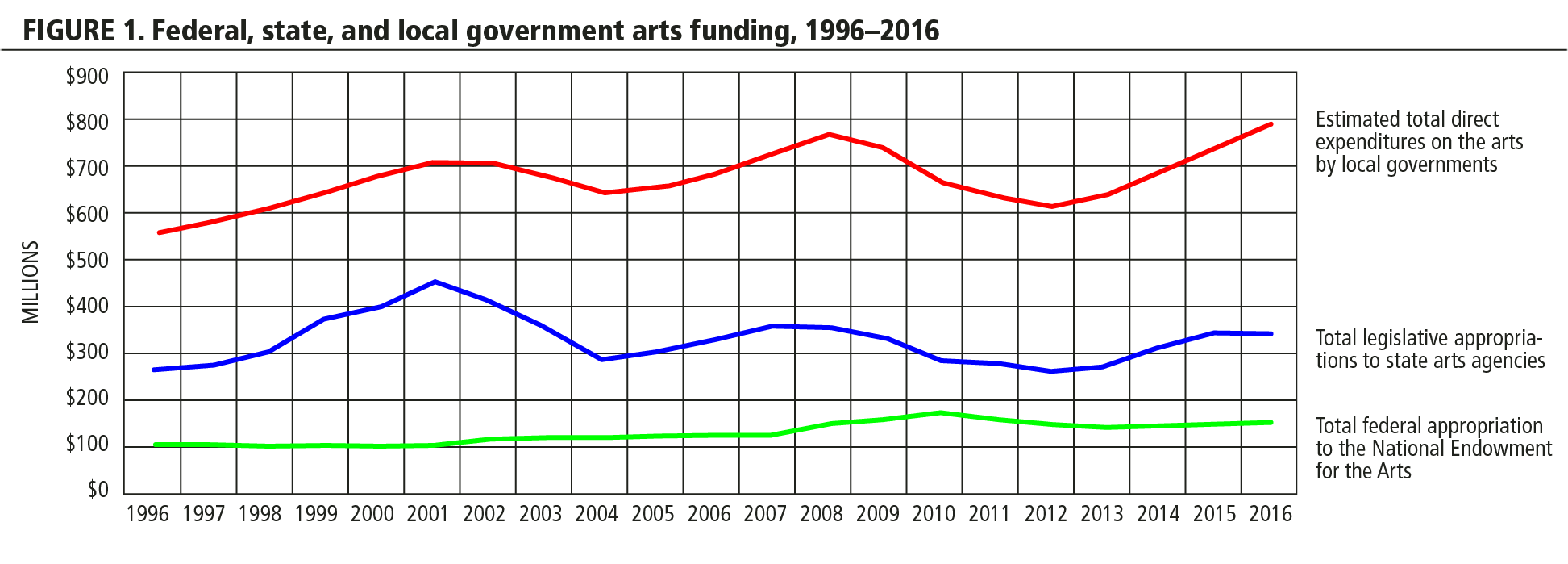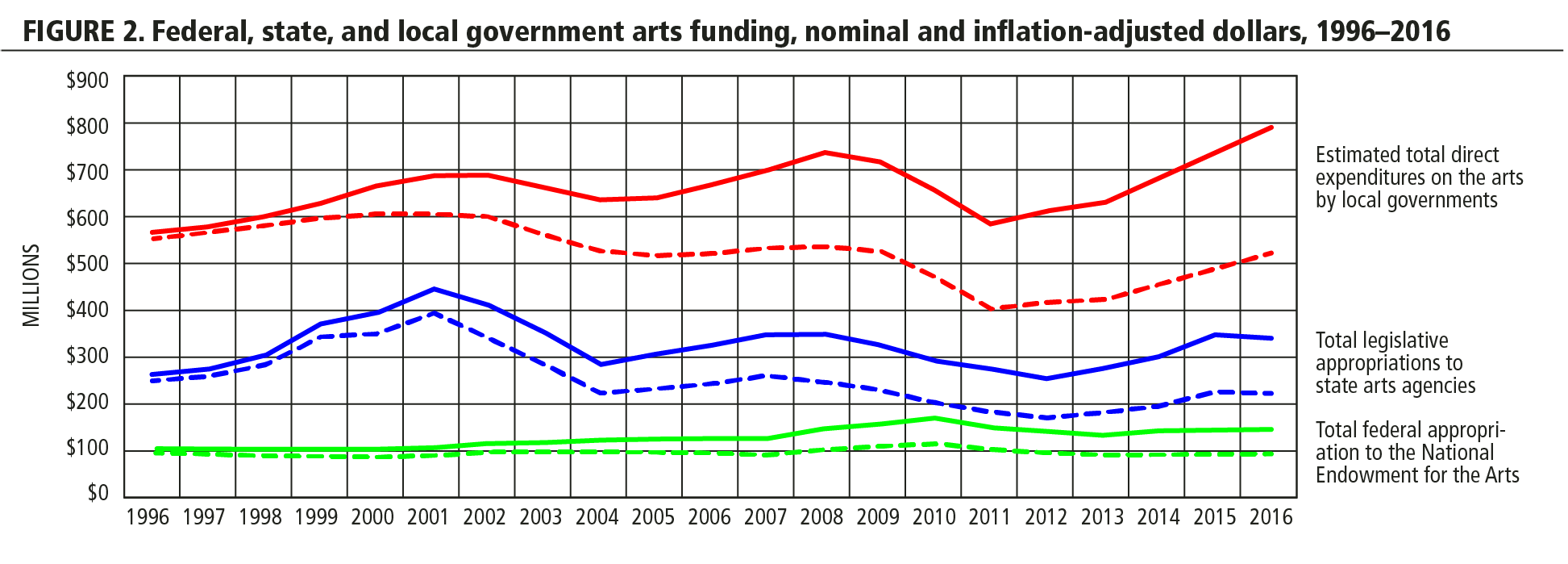Government Funding for the Arts, 2016
Download:
![]() Arts Funding Snapshot: GIA’s Annual Research on Support for Arts and Culture (3 Mb)
Arts Funding Snapshot: GIA’s Annual Research on Support for Arts and Culture (3 Mb)
Earned income and private giving make up the largest share of arts funding in the United States, but government funds are an essential piece of the arts ecosystem. Public investments in the arts are citizen driven and beholden to the public interest. They support inclusive experiences, promulgated by representative democracy covering every part of the country.
Public funding for the arts is best understood by tracking three key sources: congressional allocations to the National Endowment for the Arts (NEA), legislative appropriations to the nation’s state arts agencies, and funds allocated by local governments to local arts agencies. These entities are responsible for the distribution of public grants and services to artists, arts organizations, and other creative entities across the nation. Public funding for the arts totaled $1.29 billion in FY2016.
The Economic Context of Public Arts Funding
Cultural producers are entrepreneurial with motivations that span from profit margins to social impact. The value of the arts to society has a similar range of benefits, from intrinsic to economic. This cross-sectoral variety of players and participants necessitates several funding types. Earned income, investments, contributed revenue, and government support all play a role.
Payments received for the consumption of artistic goods and services make up a majority of the arts ecosystem in the United States. The Bureau of Economic Analysis, the definitive producer of such figures, shows the economic contribution of arts and culture to be over $700 billion,1 greater than both the tourism industry and the construction industry. This staggering figure speaks to the integrated nature of the arts in our economy and society.
Consistent with all major industries, the arts require public partnerships to maintain infrastructure, generate wealth, and allow for access to services. Compared to other industries, such as construction, transportation, and health care, taxpayer investment in the arts is remarkably low. For example, transportation and economic development programs constitute 18 percent of federal nondefense discretionary spending.2 The federal budget for the NEA constitutes 0.025 percent of nondefense discretionary spending.
2016 Funding Levels
The federal government, states, and localities appropriated a combined $1.29 billion to the arts in FY2016, for a total per capita investment of $3.97. Comprising this total were the following:
- $147.9 million in appropriations to the NEA, an increase of 1.32 percent from FY2015
- $349 million in legislative appropriations to state and jurisdictional arts agencies, a decrease of 0.3 percent from FY2015
- $795 million in funds allocated by local governments to local arts agencies,3 an increase of 4.7 percent from FY2015
Trends over Time
In nominal dollars (not adjusted for inflation), public funding for the arts by federal, state, and local governments increased by 40 percent over the past twenty years. State and local funding patterns have largely corresponded with periods of economic growth and recession. Aggregate appropriations to state arts agencies reached a high point in 2001, and local funders reported their highest point in 2016. Federal funding for the NEA has displayed incremental growth after sustaining large cuts in the mid-1990s.
Despite these nominal dollar increases, public funding for the arts has not kept pace with inflation. When adjusting for inflation, total public funding for the arts has actually decreased by 7 percent over the past twenty years. In constant dollar terms, state arts agency appropriations decreased by 12 percent, local funding contracted by 6 percent, and federal funds have remained essentially flat, decreasing by 2 percent.
Implications for Grantmaking
Appropriations for state, local, and federal arts agencies drive the availability of grant dollars. For example, trends in grantmaking by state arts agencies track closely with appropriations to state arts agencies over time.4 When state arts agency appropriations declined by 26 percent during the great recession between 2008 and 2012, state arts agency grant outlays declined by a nearly identical 27 percent during that same time period.
Public funders devote a significant portion of their grant dollars to grassroots community arts activity, small organizations, and underserved constituencies: groups that are geographically isolated,5 are economically challenged,6 or that face systemic obstacles to cultural resources and opportunities to access the arts.7 Government arts agencies have adopted this focus as a public principle, and it is in some instances mandated by state or federal statutes.8 As a result, reductions in appropriations to local, state, and federal arts agencies can have an especially sharp impact on marginalized communities. Increases in public appropriations for the arts can likewise be of substantial benefit to such communities.
The distribution patterns of government arts grants reflect another public sector objective of attaining maximum geographic coverage. Given the modest appropriations described above, this often necessitates the mechanism of awarding many grants that are small in size, rather than concentrating impact via larger grants. Illustrating this is the fact that state arts agencies have a median award value of $4,390, while the median foundation award is $25,000. While the median NEA award amount is also $25,000, 49 percent of all NEA grants are less than $25,000 in size.
Federal, state, and local grantmaking decisions are made independently; however, revenues are connected at all levels of government, and legislative funding decisions ripple throughout the system. Forty percent of the NEA’s grant dollars are designated by Congress to go to state and regional arts agencies. Seventeen state arts agencies have decentralized funding mechanisms that provide block grants to local arts agencies designated as regranters. Local government grant funds are often used to match federal-state investments, as well as to support other community-based arts projects. Each level of government funding is important and plays a distinct role in ensuring that national, regional, and local needs get met. Different public sources foster multiple levels of public engagement in grantmaking through citizen representation on the panels that adjudicate the awards.
TABLE 1. Grant distribution by size of award and grantor, 2016
| Size of award | Number of foundation grants | Number of NEA grants | Number of SAA grants |
|---|---|---|---|
| >$5 million | 31 | - | - |
| $1–$5 million | 348 | 8 | 7 |
| $500,000–$999,999 | 410 | 51 | 21 |
| $100,000–$499,999 | 2,805 | 51 | 326 |
| $50,000–$99,999 | 2,824 | 278 | 547 |
| $25,000–$49,999 | 4,229 | 658 | 1,132 |
| $10,000–$24,999 | 7,656 | 1,012 | 3,599 |
| Under $10,000 | N/A | 8 | 14,718 |
| Total arts grants | 18,303 | 2,066 | 20,350 |
| Median award dollar amount | $25,000 | $25,000 | $4,390 |
Source: GIA Reader, Vol. 27, No. 1, Winter 2016. Foundation Center sample excludes grants of less than $10,000, NEA arts.gov grants search, FY2015, SAA Final Descriptive Report records, FY2015.
Complementary Roles
A larger piece of the arts funding ecosystem comes from private sector giving, which includes individuals, corporations, and foundations.9 Foundations help to drive social innovation in the arts with large investments supporting programming as well as the physical infrastructure needed to deliver arts experiences. Private funding sources may be used for experimental programs more readily than public dollars, which may be constrained by risk-mitigating regulations. Private support helps cultural producers stay ahead of the curve and rapidly capitalize new ideas. All of these functions are important but are not by themselves sufficient to deliver on art, creativity, and culture as public goods.
The cultural ecosystem requires both public and private support to thrive. Corporations and foundations that fund the arts do not exist in all communities. Government funds are modest but important, achieving wider geographic access to cultural experiences as well as access across the income spectrum. Public funds allow for citizen involvement in policy decision making. Public sector accountability requirements, while not perfect, incentivize arts organizations to provide public value in their programs and adhere to high standards of transparency, accessibility, and inclusion.
Foundations, public agencies, and their grantees all can be effective advocates for the value of the arts in our society. The scope of the arts sector includes every citizen as a stakeholder. Public funding for the arts insures that governments continue to be stakeholders in art as a public good and that the public and private sectors both continue to fuel arts investments. The National Arts and Humanities Foundation Act of 1965 notes that it is necessary for government to support a “climate encouraging freedom of thought, imagination, and inquiry” because “democracy demands wisdom and vision in its citizens.” Over fifty years, the importance and wisdom of public investments in the arts remain. Research continues to build a body of evidence showing the educational, economic, and civic benefits of arts. Artists and arts organizations continue to create and produce in challenging funding environments. This enduring work and investment by citizens and governments remains in the collective spirit of the United States.
Ryan Stubbs is the research director, National Assembly of State Arts Agencies.
NOTES
This profile draws on local spending estimates from Americans for the Arts, NASAA’s legislative appropriations surveys of the nation’s state and jurisdictional arts agencies, and appropriations data from the NEA. As of this writing, the most recent data available about federal and local funding for the arts are from FY2016. FY2017 data for state arts agencies are available from www.nasaa-arts.org. Constant dollar adjustments for inflation are calculated using Bureau of Labor Statistics Consumer Price Index (CPI) figures with a base year of 1996. Per capita calculations are based on national population estimates from the US Census Bureau.
- NEA Arts and Cultural Production Satellite Account Issue Brief #1, https://www.arts.gov/sites/default/files/ADP%239-Brief1.pdf.
- Office of Management and Budget Analysis BY CBPP, http://www.cbpp.org/research/policy-basics-non-defense-discretionary-programs.
- Americans for the Arts substantially changed the methodology for collecting local arts agency investments through the local arts agency census in 2016. The most recent five years of local arts agency data are based on the 1,128 census respondents. Annual estimates are used prior to 2011.
- State Arts Agency Grant-Making Statistics, 2016, http://www.nasaa-arts.org/Research/Grant-Making/index.php.
- See “State Arts Agency Fact Sheet: Support for Arts in Rural Areas,” http://www.nasaa-arts.org/Research/Grant-Making/RuralGrantmakingFactSheet0316.pdf.
- See “State Arts Agencies Create More Equitable Access to the Arts,” http://www.nasaa-arts.org/Research/Grant-Making/SAAsCreateEquitableAccesstotheArts.pdf.
- See “State Policies and Programs Addressing Diversity, http://www.nasaa-arts.org/Research/Best-Practices/State-Policies-and-Programs-Addressing-Diversity.pdf; “2015 Local Arts Agency Census Diversity and Equity,” http://www.americansforthearts.org/sites/default/files/DiversityEquity_v4.pdf.
- For example, see the National Foundation on the Arts and Humanities Act, §954(c), paragraphs (a) and (b) as amended by P.L. 111–88, Sec. 439; https://www.arts.gov/sites/default/files/Legislation.pdf.
- Foundation Center, “Foundation Grants to Arts and Culture 2013,” http://www.giarts.org/article/foundation-grants-arts-and-culture-2013.


